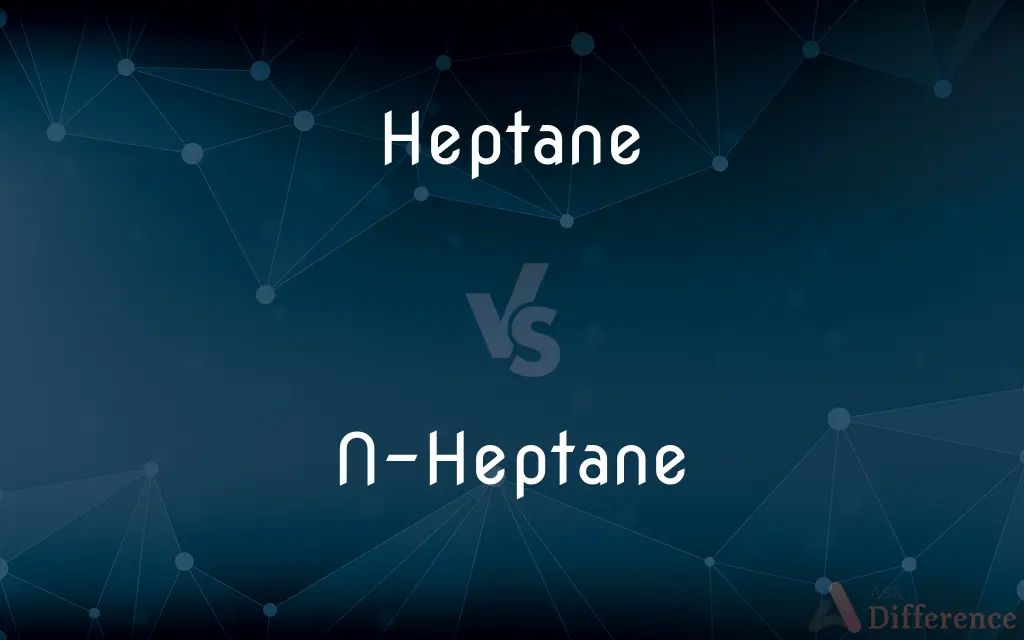Heptane vs. N-Heptane — What's the Difference?
By Fiza Rafique & Maham Liaqat — Published on August 23, 2024
Heptane is a hydrocarbon with several isomers, including n-heptane, which is the straight-chain form of heptane with specific industrial and lab uses.

Difference Between Heptane and N-Heptane
Table of Contents
ADVERTISEMENT
Key Differences
Heptane refers to a group of hydrocarbons with the molecular formula C7H16, encompassing several isomers that differ in the structure of their carbon chains. This diversity makes heptane useful in various industrial applications, such as solvents and fuels, depending on the specific properties of each isomer. On the other hand, n-heptane specifically refers to the straight-chain isomer of heptane. It is often used as a reference standard in octane rating, highlighting its importance in assessing the combustion quality of gasoline.
The physical properties of heptane isomers can vary significantly. For instance, the boiling point, melting point, and viscosity of each isomer differ, affecting their suitability for certain applications. N-heptane, with its straight-chain structure, typically exhibits properties that make it ideal for use in laboratories and as a benchmark in octane rating tests. Conversely, other heptane isomers might be preferred in industrial applications where their specific physical characteristics, such as lower boiling points or differing solubility, are advantageous.
In terms of usage, heptane, as a broader category, finds its place in a wide range of applications from solvents in paints and coatings to a component of gasoline. This versatility stems from the various properties of its isomers. N-heptane, with its more defined role, is particularly valued in scientific research and quality control in the petroleum industry due to its consistent and well-understood characteristics.
Safety considerations for heptane and n-heptane involve understanding their flammability and potential health impacts. Both are highly flammable and can cause respiratory issues, dizziness, or even long-term health effects with prolonged exposure. However, handling standards and safety protocols are well established, particularly for n-heptane in laboratory settings, where its use is common.
Environmental impact is another aspect where both heptane and n-heptane share concerns. Being hydrocarbons, their release into the environment can contribute to pollution and pose risks to aquatic life. The production, use, and disposal of these compounds necessitate careful management to minimize environmental harm.
ADVERTISEMENT
Comparison Chart
Molecular Formula
C7H16
C7H16
Isomers
Multiple, including n-heptane
Single (straight-chain)
Usage
Solvents, fuels, and various industrial applications
Reference standard in octane rating, laboratory solvent
Physical Properties
Varies by isomer
Consistent, due to its straight-chain structure
Safety
Highly flammable, health risks
Highly flammable, established safety protocols in labs
Environmental Impact
Potential pollution and aquatic life risks
Similar, with emphasis on controlled usage and disposal
Compare with Definitions
Heptane
Utilized in the production of rubber and plastics.
Heptane acts as a solvent in the rubber manufacturing process.
N-Heptane
Used in the calibration of fuel-testing equipment.
N-heptane's combustion quality is a benchmark in engine tests.
Heptane
A hydrocarbon with the molecular formula C7H16, consisting of several isomers.
Heptane is used as a solvent in industrial applications.
N-Heptane
Has a defined boiling point, useful in refining processes.
The boiling point of n-heptane is critical for its separation from crude oil.
Heptane
Found in crude oil and natural gas, contributing to gasoline's composition.
Heptane mixtures improve gasoline's volatility.
N-Heptane
Preferred in laboratories for its consistent properties.
N-heptane serves as a solvent in organic synthesis.
Heptane
Its isomers have varying boiling points and physical properties.
The boiling point of heptane isomers influences their distillation.
N-Heptane
Exposure risks similar to heptane but with stricter handling protocols.
N-heptane use in labs requires adherence to safety standards.
Heptane
Can cause respiratory and nervous system effects upon exposure.
Proper ventilation is required when working with heptane.
N-Heptane
The straight-chain isomer of heptane, known for its purity and stability.
N-heptane is used as a standard in octane rating tests.
Heptane
Any of several isomeric, volatile, colorless, highly flammable liquid hydrocarbons, C7H16, obtained in the fractional distillation of petroleum and used as solvents. The straight-chain isomer is also used as a standard in determining octane ratings and as an anesthetic.
N-Heptane
(organic compound) The saturated aliphatic hydrocarbon (CH3(CH2)5CH3).
Heptane
(organic compound) Any of the nine isomers of the saturated aliphatic hydrocarbon C7H16, obtained from petroleum, especially n-heptane (CH3(CH2)5CH3)
Heptane
Any one of several isometric hydrocarbons, C7H16, of the paraffin series (nine are possible, four are known); - so called because the molecule has seven carbon atoms. Specifically, a colorless liquid, found as a constituent of petroleum, in the tar oil of cannel coal, etc.
Heptane
A colorless volatile highly flammable liquid obtained from petroleum and used as an anesthetic or a solvent or in determining octane ratings
Common Curiosities
Why is n-heptane important in the petroleum industry?
N-heptane serves as a reference standard in octane rating, essential for assessing gasoline's combustion quality.
How do the environmental impacts of heptane and n-heptane compare?
Both can contribute to environmental pollution, but their controlled use and disposal can minimize adverse effects.
What distinguishes heptane from n-heptane?
Heptane refers to a group of hydrocarbons with multiple isomers, while n-heptane is the straight-chain isomer with specific uses due to its stable properties.
Are there safety concerns associated with heptane and n-heptane?
Both compounds are highly flammable and can impact health, necessitating proper safety protocols during handling.
How do the physical properties of heptane isomers affect their applications?
The physical properties, such as boiling point and viscosity, vary among heptane isomers, determining their suitability for different industrial and laboratory applications.
What are the regulatory standards for using heptane and n-heptane in industries?
Regulations may include limits on emissions, exposure standards for workers, and guidelines for safe handling and disposal to minimize environmental and health impacts.
Why is n-heptane used as a reference in octane rating tests?
N-heptane has a well-defined combustion behavior, making it a reliable standard for comparing the anti-knock properties of gasoline.
How do manufacturers determine which heptane isomer to use in their products?
The choice depends on the desired physical and chemical properties needed for the product, such as volatility, solubility, and reactivity.
Can both heptane and n-heptane be used as solvents?
Yes, both are used as solvents, but n-heptane's consistent properties make it particularly suitable for laboratory and precise industrial applications.
What is the role of heptane in gasoline?
Heptane and its isomers, including n-heptane, are components of gasoline, contributing to its volatility and combustion properties.
Is there a difference in the environmental impact between heptane and n-heptane?
The environmental impact is similar for both, but the specific use and disposal practices can influence the extent of their effects.
What safety measures should be taken when handling heptane or n-heptane?
Safety measures include using proper ventilation, wearing protective equipment, and following handling and storage guidelines to prevent fire and health risks.
Can exposure to heptane or n-heptane have long-term health effects?
Prolonged exposure to heptane or n-heptane can lead to neurological and respiratory issues, emphasizing the need for proper safety measures.
How are heptane and n-heptane produced?
Both are derived from crude oil through the refining process, with n-heptane often further purified for specific uses.
How do the boiling points of heptane isomers influence their distillation and purification?
The varying boiling points allow for the separation of isomers through distillation, enabling the purification of specific isomers like n-heptane for specialized applications.
Share Your Discovery

Previous Comparison
Plush Mattress vs. Pillow Top Mattress
Next Comparison
Carbon Steel vs. Stainless SteelAuthor Spotlight
Written by
Fiza RafiqueFiza Rafique is a skilled content writer at AskDifference.com, where she meticulously refines and enhances written pieces. Drawing from her vast editorial expertise, Fiza ensures clarity, accuracy, and precision in every article. Passionate about language, she continually seeks to elevate the quality of content for readers worldwide.
Co-written by
Maham Liaqat












































